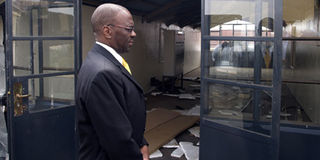Mutunga exposes fraud in courts

Chief Justice Willy Mutunga during an inspection of the Milimani Law Courts November 29, 201. He suspended all ongoing court construction projects following revelations of corruption and poor workmanship at the recently refurbished building in Upper Hill, Nairobi. BILLY MUTAI
Chief Justice Willy Mutunga on Tuesday revealed corruption at the heart of the judiciary and ordered a stop to construction of court buildings until an audit is done.
Justice Mutunga took journalists on a tour of the Milimani courts, opened only in February, but which have in some instances degenerated with collapsed ceiling and malfunctioning locks.
The cost of refurbishing the former income tax department building shot from Sh600 million to Sh1 billion and it took eight years to be completed—after a three-year delay.
Dr Mutunga said all construction of judiciary buildings country wide would be stopped to pave way for structural, forensic and financial audits following revelations of corruption and poor workmanship.
The action by Dr Mutunga follows warnings that the recently refurbished Milimani Law Courts in Upper Hill, Nairobi, were in danger of collapsing.
The structural audit, he said, would be conducted by the Ministry of Public Works who, ironically, supervised the contractors.
He said they would be joined by an independent institution.
A forensic and financial audit, the CJ said, would also be done on the Milimani and Kisumu law courts projects.
Caved in three times
The judiciary boss also asked the professional bodies to take punitive action against their members who would be found to have delivered the shoddy construction.
“We appreciate the pressure to construct courts and for the demand for space. However, if in our haste to meet this demand, this is the quality of construction we are going to get, then that investment will not only be reckless but also wasteful,” Dr Mutunga said.
The ceilings in the Milimani court rooms have caved in three times in the past three months.
A police officer was injured in the last incident while others are said to have occurred when the courts were not in session.
The exquisite finishing of the newly-refurbished courts as seen from outside seem to be the direct opposite of the interior.
The building now poses grave danger to staff and public as a result of myriad structural malfunctions that include broken sewers, caving in ceilings, poor workmanship, lack of internet connection and a VIP lift that stopped functioning five months after commissioning.
Poster project of corruption
Dr Mutunga placed the court’s staff on a high alert while inside the building which he said was in a “sorry state of disrepair”.
“We intended to construct an ultra modern building; however what we have ended up with is a poster project of corruption and failure of the engineering, architectural and engineering professions,” he said.
The contract to refurbish the building was awarded to NK Brothers Construction Company, the firm behind the controversial military projects worth Sh4 billion.
Criminal negligence
In May this year, Parliament’s Defence and Foreign Relations Committee doubted NK Brother’s ability to do government jobs that it had tendered for following the military contract debacle.
Pegrume Limited Telecommunications Services was contracted to install ICT infrastructure.
Both firms have yet to submit construction files to the judiciary eight months later, according to Dr Mutunga.
“This speaks of criminal negligence and serious dereliction of duty,” the CJ said.
He called on the Architectural Association of Kenya and the Institution of Engineers of Kenya to take disciplinary action against its members involved in the substandard construction of judiciary facilities.
The court house building was meant to have the latest ICT basic infrastructure including stand-by generators and security surveillance systems.
However, the contractor failed to install the ICT these facilities
The building also does not have functional CCTV and the few available have broken down.
The access control has not been activated thereby compromising the security of sensitive areas within the building.




